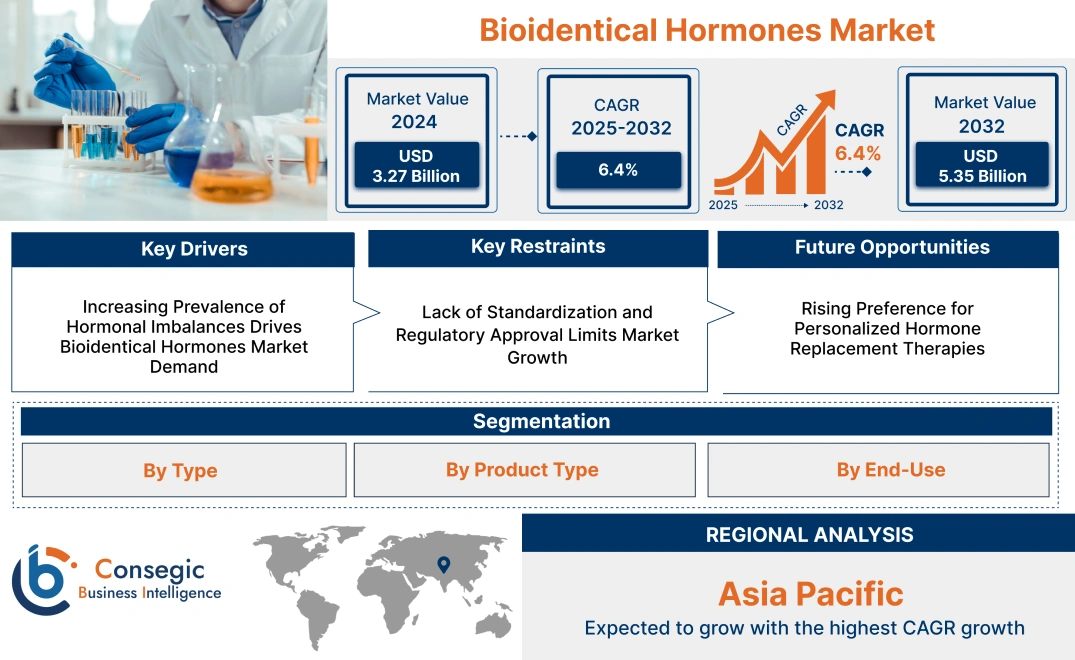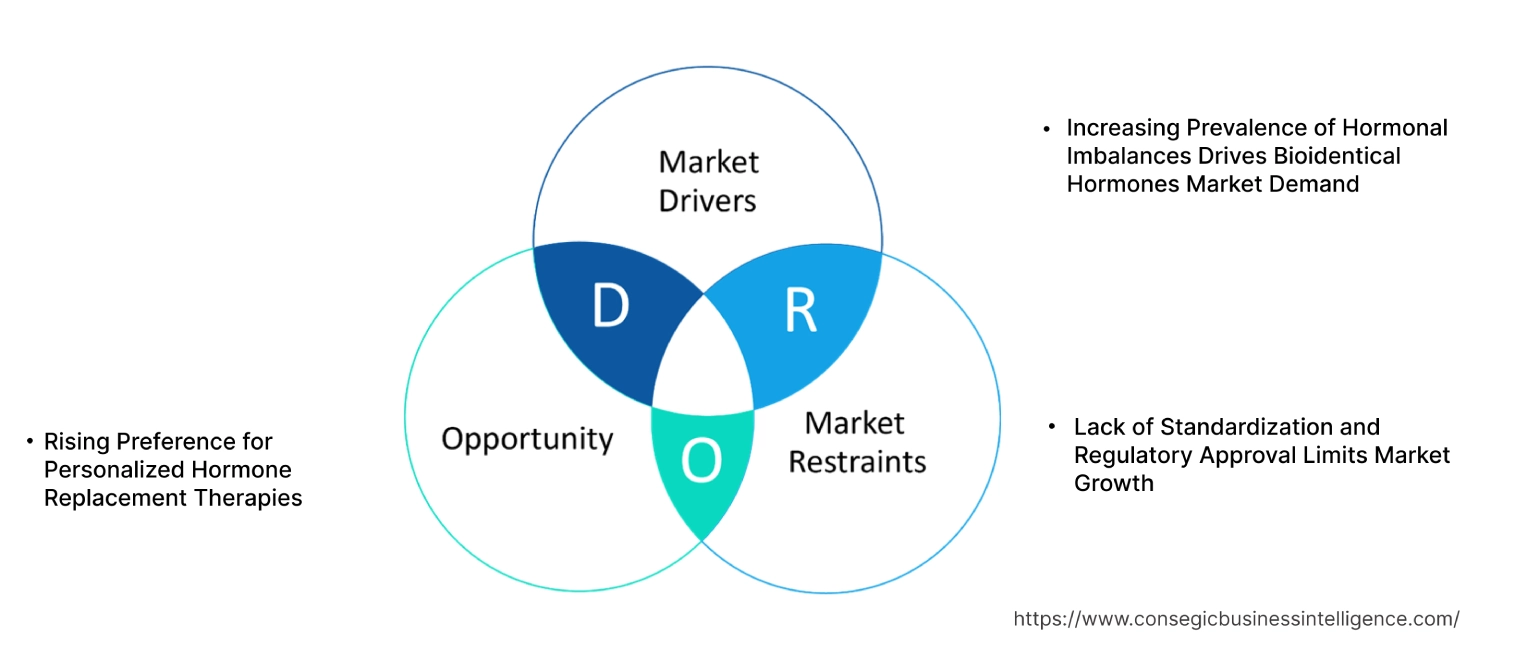Bioidentical Hormones Market Size:
Bioidentical Hormones Market size is estimated to reach over USD 5.35 Billion by 2032 from a value of USD 3.27 Billion in 2024 and is projected to grow by USD 3.42 Billion in 2025, growing at a CAGR of 6.4 % from 2025 to 2032.
Bioidentical Hormones Market Scope & Overview:
Bioidentical hormones are structurally and chemically identical to the hormones naturally produced by the human body. These hormones are often derived from plants and modified to match the molecular structure of endogenous hormones like estradiol, estrone, estriol, progesterone, testosterone, and others. These hormones are used in hormone replacement therapy (HRT) to address hormone imbalances, particularly in women experiencing menopause.
Bioidentical Hormones Market Dynamics - (DRO) :
Key Drivers:
Increasing Use of Bioidentical Hormones in Hormone Replacement Therapy Drives Bioidentical Hormones Market Demand
Bioidentical hormone replacement therapy (BHRT) is a form of hormone replacement therapy that uses hormones chemically identical to those produced by the body, often in custom-compounded formulations. BHRT often involves individualized treatment plans, sometimes based on hormone level testing, to modify the dosage and type of hormone. Many BHRT products are compounded by pharmacies, which allows variations in hormone levels and combinations that are not found in standard FDA-approved medications.
Moreover, BHRT alleviates symptoms of menopause, such as hot flashes, mood swings, and others, by replenishing hormones that decline during menopause. Additionally, the advantages offered by BHRT are driving the bioidentical hormones market growth.
Key Restraints :
Increased Risk of Certain Medical Conditions Limits the Market Growth
The risks associated with bioidentical hormones vary depending on the individual, specific hormones used, dosage, and the route of administration. BHRT, particularly estrogen-based therapies, increases the risk of blood clots (venous thromboembolism) and stroke. Moreover, BHRT can increase the risk of breast cancer. Gallbladder disease and heart disease are also potential risks associated with BHRT. Thus, the market analysis depicts that the increased risk of various medical conditions after the usage of these hormones is hindering the bioidentical hormones market growth.
Future Opportunities :
Rising Advancements in Customized Bioidentical Hormones Provide Market Opportunities
Bioidentical hormones can be customized in terms of hormone type, dosage, and route of administration (e.g., creams, gels, patches, oral preparations) to match individual needs. Specialized compounding pharmacies create personalized hormone formulations based on a patient's specific hormonal needs and preferences. Advancements in compounding techniques and lab technology have improved the precision and accuracy of bioidentical hormone therapy (BHT) formulations, making them more reliable and effective.
Additionally, BHT provides a more personalized approach to hormone replacement, considering the unique physiological processes of each patient. Thus, the market analysis depicts that the advancements in customized bioidentical hormones are boosting the bioidentical hormones market opportunities.
Bioidentical Hormones Market Segmental Analysis :
By Type:
Based on type, the market is segmented into Estrogen, Progesterone, Testosterone, and Combined Hormones.
Trends in the Type:
- Rising demand for bioidentical estrogen in elder women to manage menopausal symptoms is driving the bioidentical hormones market size.
- Increasing trend in the adoption of progesterone to offer a lower risk option as compared to synthetic progestins is driving the market.
Estrogens accounted for the largest revenue share of 41.75% in the bioidentical hormones market share in 2024.
- Bioidentical hormones are plant-derived hormones that are chemically identical to the hormones produced by the human body. In the case of estrogen, the most common bioidentical form is 17β-estradiol.
- Bioidentical estrogen is often used in HRT, particularly for women experiencing menopause, to help manage menopausal symptoms like hot flashes, night sweats, mood swings, and others.
- By providing the body with estrogen that is structurally identical to its own, bioidentical estrogen can help restore hormonal balance and address the symptoms associated with menopause.
- Bioidentical estrogen is available in various forms, including pills, patches, creams, and gels. These different forms allow different routes of administration and absorption.
- Bioidentical estrogen can improve bone density, enhance vaginal health, and regulate mood.
- Thus, the market analysis depicts that the benefits provided by bioidentical estrogen are driving the bioidentical hormones market demand.
Progesterone is expected to witness the fastest CAGR growth during the forecast period.
- Bioidentical progesterone is designed to have the same chemical structure as natural progesterone, making it more closely resemble the body's own hormones.
- Bioidentical progesterone offers benefits such as improved sleep, reduced hot flashes, and potentially lower risks as compared to synthetic progestins.
- Bioidentical progesterone is safer than synthetic progestins, which are linked to an increased risk of breast cancer and other health issues.
- Thus, the market analysis shows that the aforementioned factors are expected to boost the bioidentical hormones market trends.
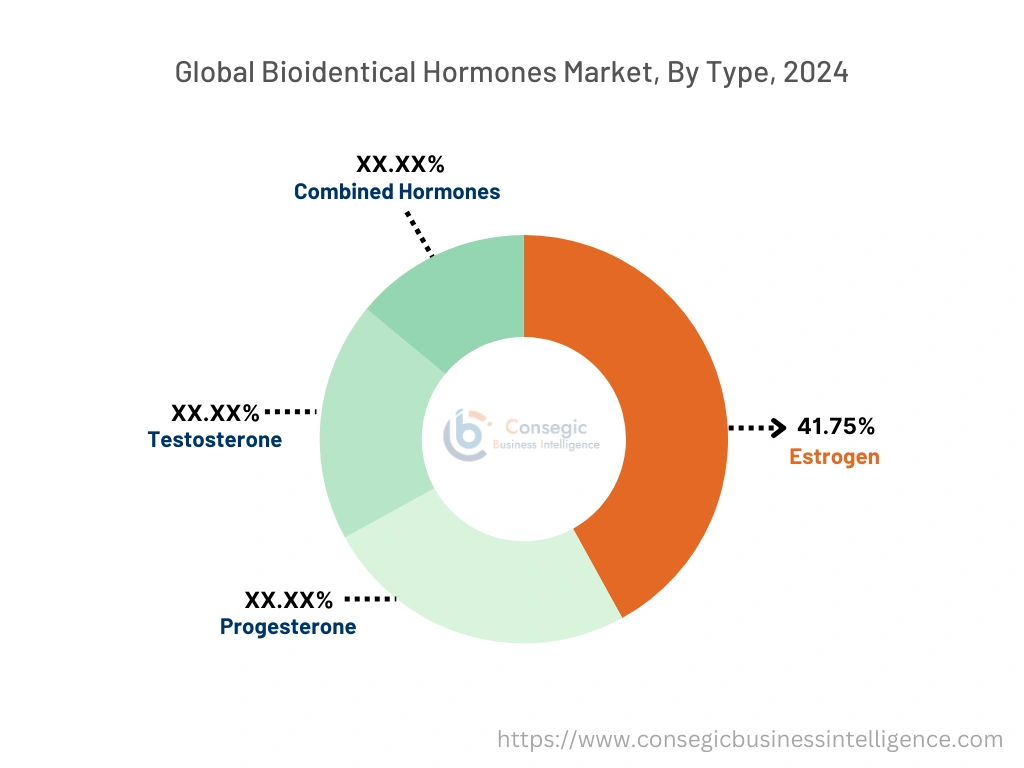
By Product Type:
Based on product type, the market is segmented into Tablets and Capsules, Creams and Gels, Injectable, Patches, and Implants.
Trends in Product Type:
- Rising demand for implants to provide a steady, consistent release of hormones into the body.
- Increasing trend in the adoption of injectables to directly release hormones into the bloodstream is boosting the bioidentical hormones market size.
Tablets and capsules accounted for the largest revenue share in the bioidentical hormones market share in 2024.
- Tablets and capsules are an oral form of delivery, offering a safe and effective way.
- They offer consistent dosage, long shelf life, stability, and enhanced bioavailability.
- Moreover, they are quickly absorbed and can handle large doses of materials.
- Thus, the bioidentical hormones market analysis shows that the benefits provided by tablets and capsules are boosting the bioidentical hormones market trends.
Creams and gels are expected to have the fastest CAGR growth during the forecast period.
- Creams and gels are applied directly to the skin, allowing the hormones to be absorbed into the bloodstream without passing through the digestive system and liver.
- Topical application can provide a more localized effect, potentially reducing systemic side effects.
- They bypass the liver, reducing first-pass metabolism and potentially leading to more consistent hormone levels.
- Thus, the bioidentical hormones market analysis shows that the aforementioned factors are expected to boost the bioidentical hormones market expansion.
By End-Use:
Based on end-use, the market is segmented into Hospitals, Gynecology Clinics, Academic and Research Institutes, and Others.
Trends in the End-Use:
- Rising demand for bioidentical hormones in academic and research institutes is driving innovative new solutions and methodologies.
- Increasing trend in adoption of gynecology clinics due to their domain-specific expertise and specialty.
Hospitals accounted for the largest revenue share in the market in 2024.
- Hospitals, particularly those specializing in women's health or endocrinology, may offer hormone replacement therapies that require bioidentical hormones.
- Hospitals often have experienced endocrinologists or other specialists who can assess individual needs and develop personalized BHRT plans.
- Hospitals offer a range of services related to BHRT, including hormone testing, counseling, and follow-up care.
- Hospitals follow quality standards and regulations, which provide reassurance about the safety and efficacy of BHRT.
- For instance, in May 2025, PB Healthcare raised USD 218 Million, to launch hospital network. It expects to build a 1000 bed network.
- Thus, the aforementioned factors are driving the bioidentical hormones market expansion.
Gynecology clinics are expected to register the fastest CAGR growth during the forecast period.
- Gynecology clinics are specialized in women's health, hormone therapy, or endocrinology.
- Using the domain expertise and specialized equipment, gynecology clinics offer precise and customized care options.
- These clinics provide advanced treatment options and also focus on research and development to innovate new solutions.
- For instance, in February 2025, SRM Global Hospitals launched Centre for Women’s Health and Wellness. The center aims to provide high-quality, and patient-focused medical services.
- Thus, the aforementioned factors are expected to boost the bioidentical hormones market opportunities.
Regional Analysis:
The regions covered are North America, Europe, Asia Pacific, the Middle East and Africa, and Latin America.
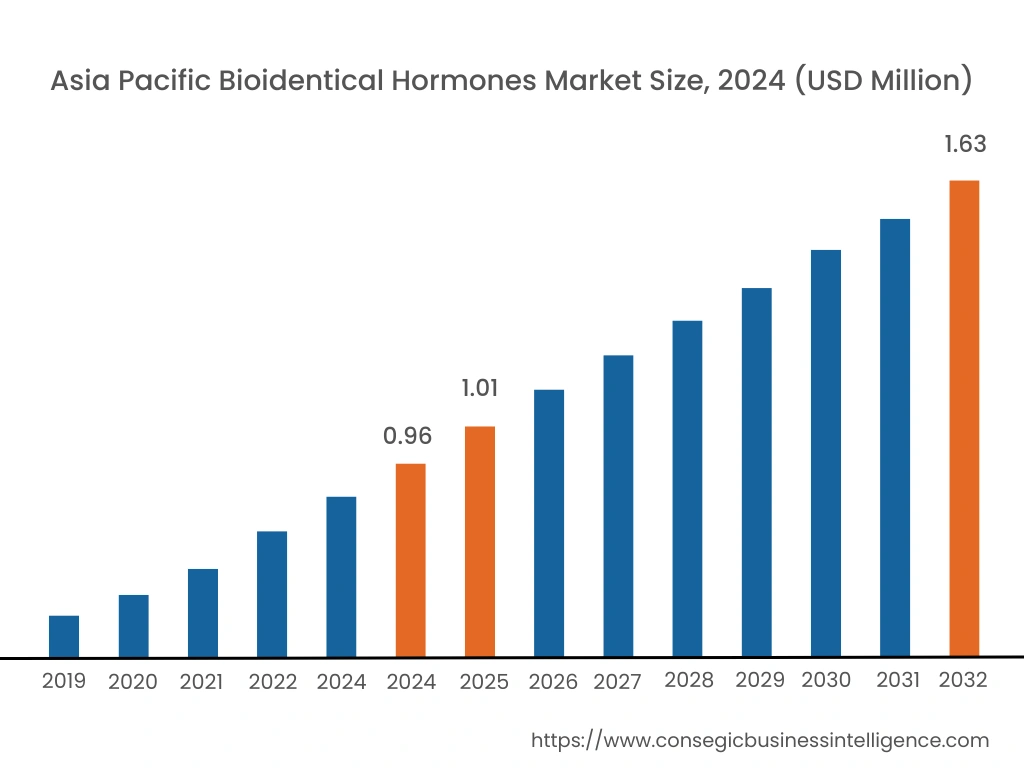
Asia Pacific region was valued at USD 0.96 Billion in 2024. Moreover, it is projected to grow by USD 1.01 Billion in 2025 and reach over USD 1.63 Billion by 2032. Out of these, China accounted for the largest share of 31.7% in 2024. The market in the region is growing due to the rising awareness about women's health. Moreover, in countries like India, China, and Japan, there is an increasing trend in healthcare investments leading to innovations, research, and development in the bioidentical hormones industry.
- For instance, in March 2025, Marengo Asia Hospitals, Gurugram launched a new dedicated clinic at South City Park 2. This indiciates the utilization of bioidentical hormones in hospitals providing treatments.
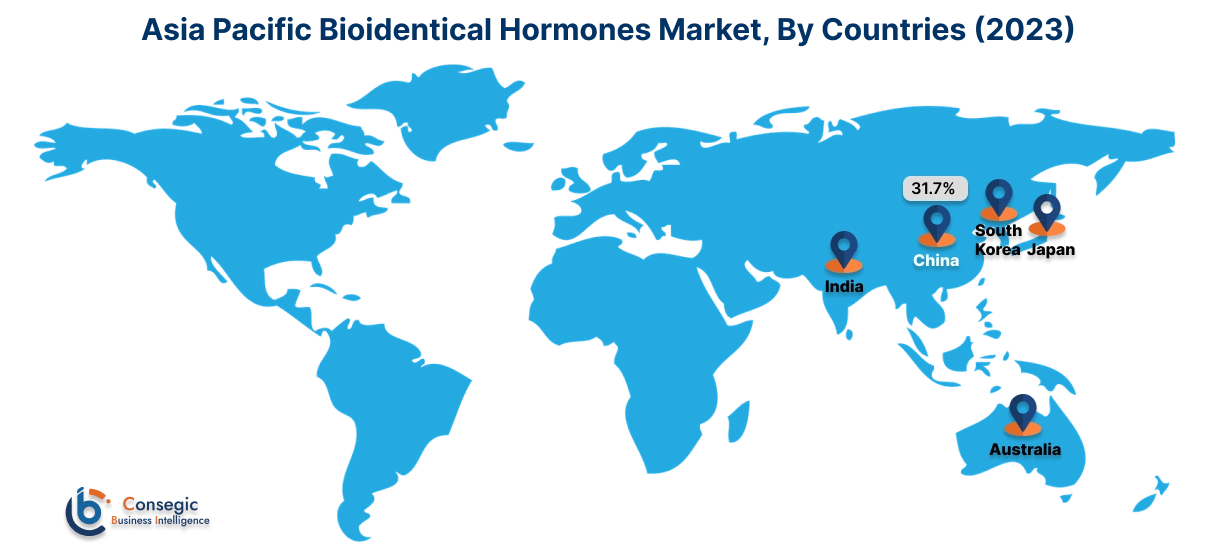
North America is estimated to reach over 1.73 Billion by 2032 from a value of USD 1.08 Billion in 2024 and is projected to grow by USD 1.13 Billion in 2025. North America leads the global bioidentical hormones market, driven by a high prevalence of hormone-related health conditions and a strong preference for personalized medicine.
In Europe, the bioidentical hormones market is expanding due to due to rising incidences of hormonal imbalances and a shift towards natural treatment options, leading to the adoption of bioidentical hormones for the treatment. In the Middle East and Africa, the bioidentical hormones market is emerging, due to rising investments in medical technologies and advancements in HRT and personalized medicine. Latin America is witnessing gradual growth in the bioidentical hormones market, driven by the rising awareness and adoption of bioidentical hormones in the region.
Top Key Players & Market Share Insights:
The bioidentical hormones market is highly competitive with major players providing products and services to the national and international markets. Key players are adopting several strategies in research and development (R&D), product innovation, and end-user launches to hold a strong position in the global bioidentical hormones market. Key players in the bioidentical hormones industry include -
- SottoPelle (United States)
- BioTE Medical (United States)
- Advantage Pharmaceuticals (United States)
- Full Life Wellness Center (United States)
- Neuva Aesthetics (United States)
- Novartis AG (Switzerland)
- Orion Pharma AB (Finland)
- Bayer AG (Germany)
- Merck KGaA (Germany)
- Pfizer Inc. (United States)
Bioidentical Hormones Market Report Insights :
| Report Attributes | Report Details |
| Study Timeline | 2019-2032 |
| Market Size in 2032 | USD 5.35 Billion |
| CAGR (2025-2032) | 6.4% |
| By Type |
|
| By Product Type |
|
| By End-use |
|
| By Region |
|
| Key Players |
|
| North America | U.S. Canada Mexico |
| Europe | U.K. Germany France Spain Italy Russia Benelux Rest of Europe |
| APAC | China South Korea Japan India Australia ASEAN Rest of Asia-Pacific |
| Middle East and Africa | GCC Turkey South Africa Rest of MEA |
| LATAM | Brazil Argentina Chile Rest of LATAM |
| Report Coverage |
|
Key Questions Answered in the Report
What is driving the bioidentical hormones market growth? +
Rising demand for hormone replacement therapies and growing awareness of personalized medicine.
What are the major types of bioidentical hormones available? +
Common types include estrogen, progesterone, and testosterone.
Who typically uses bioidentical hormones? +
They are mainly used by individuals undergoing menopause or dealing with hormone imbalances.
How large is the bioidentical hormones market? +
The market is expanding rapidly, estimated to reach over 5.35 billion USD by 2032.
